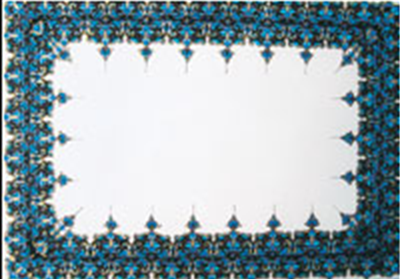Naqshi :The art of Illumination
This is a collection of articles archived for the excellence of their content. Readers will be able to edit existing articles and post new articles directly |
The art of Naqshi or illumination, closely related to calligraphy, has a long and illustrious history in Muslim arts. The artists amicably decorated the Quranic words in different colours and roses. Few civilizations in the world offer such a rich and indigenous variety of sacred arts as Islam does.
Naqshi :The art of Illumination
By Rafya Tahir
No civilisation in world offers such a rich and indigenous variety of sacred arts as Islam does.
The art of beautiful writing and decorating it with delicate and meaningful motifs was perfected by Muslim artists long before the development of book illustration and illumination in the Byzantine world. For multiple reasons (love for the Quran, being the foremost) Muslim artist explored both calligraphy and illumination to the fullest from the very beginning. Besides their functional value these arts have a strong aesthetic appeal.
The art of naqshi went through the initial stages, matured and gradually fell prey to the political and technological onslaught from 750 to 17th centuries A.D. The political instability throughout the Muslim world from 18th century onwards affected the ateliers where the art of illumination was taught and performed. Changes in economics and technology also affected the output of these ateliers which were mostly situated in Iran and the Indian Subcontinent. Lack of patronage and peaceful environment for creative activity resulted in gradual decline of this artistic vocation.
After independence in 1947, the new nation was faced with more pressing demands and attention to the development of arts and crafts was somewhat deterred. It was much later that calligraphers and illuminators started to work in small pockets but they also faced difficulties in finding a strong foothold in the new Muslim country.
An exhibition of Naqshi was recently held in the Co-opera Art Gallery Lahore showcasing the talent of amateur artists who dared to venture into this delicate and time consuming art in this modern age of computer graphics and laser printing. The exhibition was organised by the Pakistan Calligraph-Artists’ Guild, Lahore.
The work on display was painstakingly created under the guidance of Mr. Jamshaid Qaiser, an illuminator and a senior member of the Guild. Closely linked with the art of calligraphy, the art of Naqshi or illumination has a long and illustrious history in Muslim arts.
The Guild is working hard to revive the glory of Muslim artistry in the fields of Calligraphy and illumination. Since its inception in 1997, it has been holding classes for enthusiastic students as well as arranging exhibition both at national and international levels. The works on display depict the love and passion with which the art works have been produced. It was for the first time that such an exhibition has been organised in Pakistan, to promote the art of illumination to the forefront for the benefit of calligraphers and artists.
The illumination has been done in the classical style incorporating all the traditional forms like Palmettes, Roundels, Medallions, and Arrowpoint. The potential of Circle has been fully explored by the artists, combining it with rectilinear and curvilinear geometry. The colours used in the art pieces also show inclination of the artist towards the traditional and more conventional genre.
Such exhibitions contribute not only in the preservation of an art form but also in giving direction to the art literate audience and to enhance the cultural identity of a country. The efforts of the Guild must be appreciated and it is hoped that more such exhibitions will be organised.
